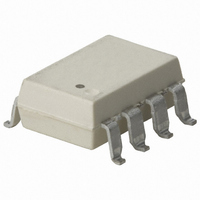HCNR201-300E Avago Technologies US Inc., HCNR201-300E Datasheet - Page 19

HCNR201-300E
Manufacturer Part Number
HCNR201-300E
Description
OPTOCOUPLER ANLG DC-1MHZ GW 8SMD
Manufacturer
Avago Technologies US Inc.
Specifications of HCNR201-300E
Output Type
Linear Photovoltaic
Input Type
DC
Package / Case
8-SMD Gull Wing
Number Of Channels
1
Voltage - Isolation
5000Vrms
Current Transfer Ratio (min)
0.36% @ 10mA
Current Transfer Ratio (max)
0.72% @ 10mA
Current - Dc Forward (if)
25mA
Mounting Type
Surface Mount, Gull Wing
Current Transfer Ratio
0.36 % to 0.72 %
Forward Current
1 mA to 20 mA
Isolation Voltage
5000 Vrms
Minimum Forward Diode Voltage
1.2 V
Output Device
Photodiode
Configuration
1 Channel
Maximum Forward Diode Voltage
1.95 V
Maximum Reverse Diode Voltage
2.5 V
Maximum Input Diode Current
25 mA
Maximum Power Dissipation
60 mW
Maximum Operating Temperature
+ 100 C
Minimum Operating Temperature
- 55 C
No. Of Channels
1
Optocoupler Output Type
Photodiode
Input Current
20mA
Output Voltage
15V
Opto Case Style
SMD
No. Of Pins
8
Forward Voltage
1.6V
Rohs Compliant
Yes
Forward Current If
25mA
Lead Free Status / RoHS Status
Lead free / RoHS Compliant
Voltage - Output
-
Current - Output / Channel
-
Vce Saturation (max)
-
Lead Free Status / Rohs Status
Lead free / RoHS Compliant
Other names
516-1609-5
Available stocks
Company
Part Number
Manufacturer
Quantity
Price
Company:
Part Number:
HCNR201-300E
Manufacturer:
AVAGO
Quantity:
30 000
The final circuit shown in Figure 19 isolates a bipolar
analog signal using only one optocoupler and generates
two output signals: an analog signal proportional to the
magnitude of the input signal and a digital signal cor‑
responding to the sign of the input signal. This circuit is
especially useful for applications where the output of
the circuit is going to be applied to an analog‑to‑digital
converter. The primary advantages of this circuit are very
good linearity and offset, with only a single gain adjust‑
ment and no offset or balance adjustments.
To achieve very high linearity for bipolar signals, the
gain should be exactly the same for both positive and
negative input polarities. This circuit achieves excellent
linearity by using a single optocoupler and a single input
resistor, which guarantees identical gain for both posi‑
tive and negative polarities of the input signal. This pre‑
cise matching of gain for both polarities is much more
difficult to obtain when separate components are used
for the different input polarities, such as is the previous
circuit.
The circuit in Figure 19 is actually very similar to the pre‑
vious circuit. As mentioned above, only one optocoupler
is used. Because a photodiode can conduct current in
only one direction, two diodes (D1 and D2) are used to
steer the input current to the appropriate terminal of
input photodiode PD1 to allow bipolar input currents.
Normally the forward voltage drops of the diodes would
cause a serious linearity or accuracy problem. However,
an additional amplifier is used to provide an appropriate
offset voltage to the other amplifiers that exactly cancels
the diode voltage drops to maintain circuit accuracy.
Diodes D3 and D4 perform two different functions; the
diodes keep their respective amplifiers active indepen‑
dent of the input signal polarity (as in the previous cir‑
cuit), and they also provide the feedback signal to PD1
that cancels the voltage drops of diodes D1 and D2.
Either a comparator or an extra op‑amp can be used to
sense the polarity of the input signal and drive an inex‑
pensive digital optocoupler, like a 6N139.
It is also possible to convert this circuit into a fully bipolar
circuit (with a bipolar output signal) by using the output
of the 6N139 to drive some CMOS switches to switch the
polarity of PD2 depending on the polarity of the input
signal, obtaining a bipolar output voltage swing.
For product information and a complete list of distributors, please go to our website:
Avago, Avago Technologies, and the A logo are trademarks of Avago Technologies in the United States and other countries.
Data subject to change. Copyright © 2005-2008 Avago Technologies. All rights reserved. Obsoletes AV01-0567EN
AV02-0886EN - November 18, 2008
www.avagotech.com
HCNR200/201 SPICE Model
Figure 20 is the net list of a SPICE macro‑model for the
HCNR200/201 high‑linearity optocoupler. The macro‑
model accurately reflects the primary characteristics of
the HCNR200/201 and should facilitate the design and
understanding of circuits using the HCNR200/201 opto‑
coupler.



















